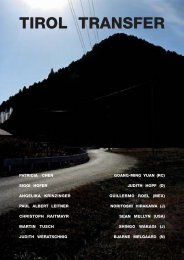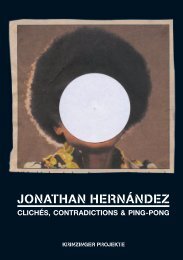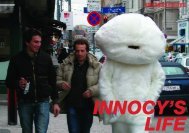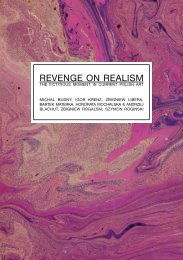post_modellismus – models in art - krinzinger projekte - Galerie ...
post_modellismus – models in art - krinzinger projekte - Galerie ...
post_modellismus – models in art - krinzinger projekte - Galerie ...
You also want an ePaper? Increase the reach of your titles
YUMPU automatically turns print PDFs into web optimized ePapers that Google loves.
aware of common modes of perception<br />
and <strong>models</strong> of explanation <strong>in</strong> different<br />
ways. At the same time all these aspects<br />
allude to the fact it is a photographic<br />
representation which is only able to construct<br />
someth<strong>in</strong>g like objective, documentary<br />
value under the cited conditions.<br />
In the case of Oliver Boberg’s work this<br />
presumed picture-immanent value of<br />
photography is always called <strong>in</strong>to question.<br />
He thus refers to the far-reach<strong>in</strong>g<br />
conventions of this prototypical case of<br />
photographic representation. In Boberg’s<br />
photographic images we follow these<br />
conventions, and discover <strong>in</strong> them not<br />
just their condition<strong>in</strong>g but also ours.<br />
Lois Renner is a pa<strong>in</strong>ter. Or to put it more<br />
precisely: he is a pa<strong>in</strong>ter who has found<br />
a significant way of deal<strong>in</strong>g with pa<strong>in</strong>t<strong>in</strong>g<br />
through photography. He dispenses with<br />
the primary medium of pa<strong>in</strong>t<strong>in</strong>g so as to<br />
test it anew by means of photography <strong>in</strong><br />
a very <strong>in</strong>cisive and paradigmatic way.<br />
Even if s<strong>in</strong>ce the early 1990s Renner has<br />
sought to overcome the ‘formal separation<br />
between photography and pa<strong>in</strong>t<strong>in</strong>g’<br />
and to ‘mix the two <strong>in</strong> a non-conflict<strong>in</strong>g<br />
manner’ 13 , he does not simply replace<br />
the medium of pa<strong>in</strong>t<strong>in</strong>g simply by another<br />
one; and he just as little merely<br />
exchanges the constitutive means of<br />
pa<strong>in</strong>t<strong>in</strong>g for those of photography. Rather,<br />
pa<strong>in</strong>t<strong>in</strong>g serves him as a medium for<br />
redef<strong>in</strong><strong>in</strong>g the picture which <strong>in</strong> a more<br />
general sense conflicts with the expectations<br />
and object <strong>models</strong> oppos<strong>in</strong>g it.<br />
Central to Renner’s def<strong>in</strong>ition of the picture<br />
is a paradigmatic reconstruction of<br />
his studio <strong>in</strong> which the myth of the<br />
<strong>art</strong>ist’s output is both celebrated and<br />
discarded. In this model of the studio<br />
Renner ascribes new roles to the objects<br />
<strong>–</strong> completely irrespective of whether one<br />
wants to refer to them as subject or<br />
object, model or reality, photography or<br />
pa<strong>in</strong>t<strong>in</strong>g.<br />
The medium Lois Renner works with is<br />
photography, but it is primarily pa<strong>in</strong>t<strong>in</strong>g<br />
and the import of the myths it creates.<br />
Us<strong>in</strong>g the model of his studio Renner<br />
presents the <strong>in</strong>stitutionalization of <strong>art</strong>istic<br />
production. He both buttresses and<br />
subverts the discourse of concealed<br />
production, ultimately rehears<strong>in</strong>g various<br />
historical <strong>models</strong> of pa<strong>in</strong>t<strong>in</strong>g. Here the<br />
pa<strong>in</strong>terly motif is always a photographic<br />
one, but it only plays the role of one or<br />
even more stand-<strong>in</strong>s. In the <strong>art</strong>ist’s<br />
words, ‘I do not deal with spaces but<br />
with social, historical or ideological<br />
forms which I want to keep or change.’ 14<br />
It is thus <strong>in</strong> the power of the pa<strong>in</strong>ter,<br />
model constructor and photographer<br />
Renner to keep or rearrange these<br />
forms. In the process, model and photography<br />
prove to be extremely suitable<br />
means to dispose of what is meant to be<br />
kept as relative truth and every order as<br />
a merely relative order: <strong>in</strong> the sense of<br />
‘lyrical visions which radically dep<strong>art</strong><br />
from a claim to an objective reproduction<br />
of a truth’. 15 That Lois Renner is able<br />
to tap this profoundly pa<strong>in</strong>terly potential<br />
precisely by means of analogue photography<br />
is one of the paradox highlights of<br />
his work.<br />
14









